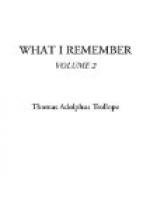“Nurse and nursling,
learner, teacher,
Thus foreshadow
things to come,
When the girl shall grow the
creature
Of false terrors
vain and dumb,
And entrust their baleful fetish with
her being’s scope and sum.
XIII.
“Then her heart shall
shrink and wither,
Custom-straitened
like her waist,
All her thought to cower together,
Huddling sheep-like
with the rest,
With the flock of soulless bodies on a
pattern schooled and laced.
XIV.
“Till the stream of
years encrust her
With a numbing
mail of stone,
Till her laugh lose half its
lustre,
And her truth
forswear its tone,
And she see God’s might and mercy
darkly through a glass alone!
XV.
“While our childhood
fair and sacred.
Sapless doctrines
doth rehearse,
And the milk of falsehoods
acrid,
Burns our babe-lips
like a curse,
Cling we must to godless prophets, as
the suckling to the nurse.
XVI.
“As the seed time, so
the reaping,
Shame on us who
overreach,
While our eyes yet smart with
weeping,
Hearts so all
our own to teach,
Better they and we lay sleeping where
the darkness hath no speech!”
[Footnote 1: Those unacquainted with the forms of the old decorated Venetian glass will hardly understand the phrase in the text. Those who know them will feel the accuracy of the picture.]
[Footnote 2: “Non toccare che brucia,” Tuscan proverb.]
It is impossible for any but those who know—not Florence, but—rural Tuscany well, to appreciate the really wonderful accuracy and picturesque perfection of the above scene from a Tuscan afternoon. But I think many others will feel the lines to be good. In the concluding stanzas, in which the writer draws her moral, there are weak lines. But in the first eleven, which paint her picture, there is not one. Every touch tells, and tells with admirable truth and vividness of presentation. In one copy of the lines which I have, the name is changed from Bice to “Flavia,” and this, I take it, because of the entire non-applicability of the latter stanzas to the child, whose rearing was in her own hands. But the picture of child and nurse—how life-like none can tell, but I—was the picture of her “baby Beatrice,” and the description simply the reproduction of things seen.
I think I may venture to print also the following lines. They are, in my opinion, far from being equal in merit to the little poem printed above, but they are pretty, and I think sufficiently good to do no discredit to her memory. Like the preceding, they have no title.
I.
“I built me a temple, and said it
should be
A shrine, and a home where the past meets
me,
And the most evanescent and fleeting of
things,
Should be lured to my temple, and shorn
of their wings,
To adorn my palace of memories.




